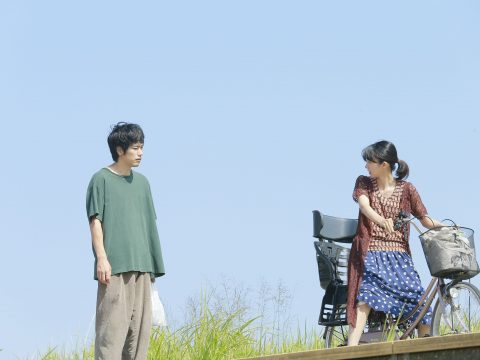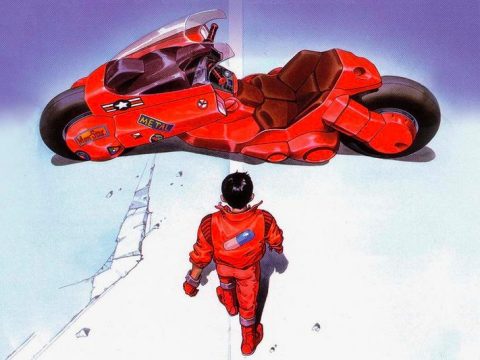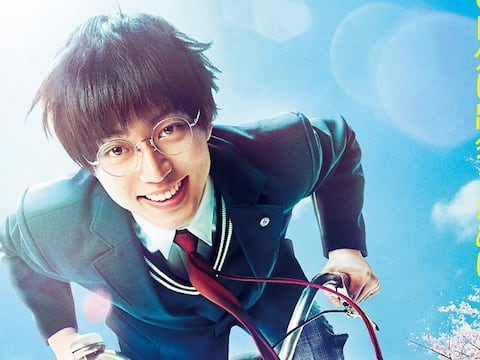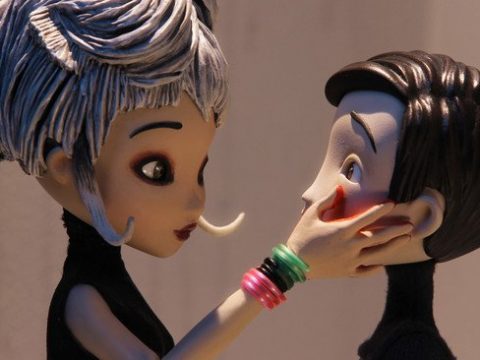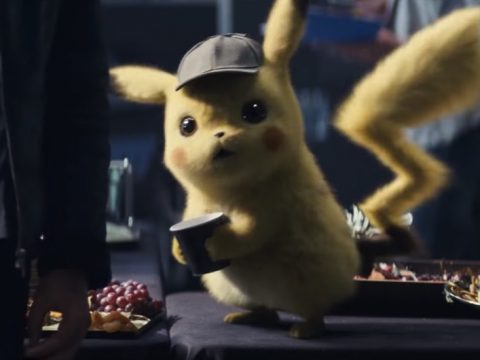
“This ain’t a laughing matter, guys! You’re gonna die!”
Filming had just started. Action director Eiji Kamikura’s first shot of the day would be the obligatory crowd running from monster shot – a crowd just shy of a dozen people in casual wear, but a crowd nonetheless. The crew double as extras, but the first take didn’t go so well. The smiles and laughter from the supposedly terrified masses failed to sell the true terror of the vicious King Ogre, leader of the Underwater Empire Zabun in the TV show Houjin Yatsurugi, the first season of which enjoyed a nationwide run on satellite TV BS12, spawned two OVA spinoffs, and the second season just started airing on local channel Chiba TV on January 7th.
However, months earlier on a hot summer day, in the portside of the sleepy Chiba town Kisarazu, the premiere is still months away and it’s been a long road. Every three filming days they’re shooting enough material for four episodes. With that in mind, it’s only 8am and the shooting schedule is calling for it to go until past midnight. On episode 11 out of twelve, it’s the home stretch and things are just looking up. One bad take isn’t going to hurt anything, but it needs to turn good. Everyone’s in their places again as Kamikura calls out “Okay, we’re taking it again. Action!”
Houjin Yatsurugi tells the story of Takeru Yamato (Yuusuke Kashiwagi), a young fisherman who discovers a stone containing the power to transform into the titular superhero. As misfortune has it, the evil lieutenants of the Underwater Empire Zabun, Fangark (Kouji Mitsumizo) and Akumarin (Natsumi Senaga), have decided to make diabolical motions to the land, creating monsters from sea creatures mutated with extractions of trash humans have thrown into the ocean, leading to such baddies as a rocket-launching sea cucumber and a knife-handed crab. Joined by his trusty friend Mari Tachibana (Akari Sasaoka), who in turn transforms into the heroine Kisara, the two engage in a fight to protect the city of Kisarazu, a small bedroom community of under 130,000 people in Chiba prefecture.

Talking with Production Coordinator Yoshinori Kushima, the choice of setting was deliberate. “Chiba TV showed interest [in the production], so we decided to make a hero based in Chiba. But where in Chiba? … Of course, with Chiba TV, we thought it’d be better to shoot in a [large] city, but that would be quite difficult to film. In a sense, shooting in a smaller location would give us more freedom, as well as cooperation from the local people.”
Indeed, part of the show’s charm is how it relishes in its local setting where most other shows try to pass off their locations as Tokyo about as much as America makes Vancouver into San Francisco. For a tokusatsu comparison, witness the Kamen Rider franchise, where Saitama Super Arena has been frequently used and re-used for everything from Ryuki‘s Mirror World to Double‘s swanky noirish city of Fuuto to Fourze’s Amanogawa High School. In stark contrast, Yatsurugi fully embraces its roots in a way rarely seen outside truly otaku fare such as Lucky Star, right down to Takeru’s battlecry of “I’ll show you… my Kisarazu Spirit!”
To that end, the show prominently features town landmarks and symbols throughout – Takeru and Mari transform with magic stones bearing the official Kisarazu seal; the town’s signature tanuki statues dotted throughout the town have the ability to talk to the heroes, dispensing advice and moral support. “You can see places around this small town, go ‘oh, it’s this place or that, and that’s part of the fun, y’know?” says Kamikura.
Adding more quirkiness to an already quirky set of circumstances, unlike Kevin Smith’s New Jersey or Woody Allen’s New York, these bits of local color were due to the cooperation of the Kisarazu City Hall and Tourism Board. The actual production studio in charge, Zen Pictures, is based in Tokyo.

Yes, Zen Pictures. While readers may not know their name, they probably have at least heard of their output. An obscure but noteworthy staple in Akihabara subculture, Zen Pictures is best known for its infamous store full of a staggering library of original tokusatsu heroine movies. Essentially, these are cheesecake videos starring various gravure idols in spandex getting into various compromising situations with low production that are boosted by surprisingly good fight choreography taken from inexperienced performers and an earnest adherence to classic tokusatsu formula.
Simple pulpy plots and hammed-up performances are the order of the day and it owes more to the Showa era of the 70s and 80s than the soap opera antics of the recent Kamen Rider and Super Sentai entries. Despite their straight delivery, though, the approach and purpose is pure gravure tease.
Obviously, Yatsurugi is quite removed from such niche genre work and is a big step into the mainstream. “We have made lots of heroine stuff but we’ve always wanted to just do a regular hero show,” said Kushima.
Fortunately, the work-a-day routine of the likes of Magnizer-1 has made the cast and crew on Yatsurugi machine-like in their production routine. With the aforementioned four-three schedule, production on the shots in the fight move quickly. Despite the relatively low budget (relying mostly on found locations) and the quick-cut, cartoony pacing of the drama scenes, the choreography that Yatsurugi and Kisara engage in with Fangark and his minions is on par with the Ishinomori Pro shows on Sunday morning.

On that, Action Director Shigeki Hayase, who has worked since he was 16, says “I grew up with Hong Kong action, so I try to make things in a more Hong Kong fashion.” To that end, the fights, including this one, are kinetic affairs, filled with lots of jumping and exaggerated perspectives, and Hayase is hands-on with his crew, flailing wildly to demonstrate how to sell the attacks.
Kamikura, whose part is more focused on ensuring that the action has continuity, is more pragmatic. “If we had more money, we would do certain things a little differently, but because we don’t, we are required to think and say ‘okay, we’ll shoot it like this’.”
Back on set, King Ogre has finished terrorizing the random people who had the misfortune of gathering at the bayside on this cloudy morning. It’s time for Kashiwagi as Takeru to take to the scene, complete with a shirt blaring “NO KICK NO LIFE.” After a bit of banter with his foe, he decides that it’s time to deal some justice, taking out his seal and crying out “Yatsurugi, shourai!” Kamikura, satisfied with the performance, dismisses Kawashiwagi from the set for the time being.
He doesn’t have much action in the morning, but later that night he’ll be going with the separate crew in charge of shooting the various drama scenes, so he sticks around in the mercifully air-conditioned van. It’s a little unusual as far as Yatsurugi goes, given that Takeru, in stark contrast to many of his bigger-budgeted contemporaries, is frequently given ample fights out of the suit. Regardless, today is relatively lax and he takes some time out of the van to talk with us (and show off some moves). Perhaps predictably given the mainstream aspirations, his movements both on and off camera are more flexible and precise than the antics of Akiballion: Battlemaids of Akihabara.

“I always wanted to do a hero show since I was a little kid. So, when my manager told me about the job, I jumped on it… [I liked] the idea of being an easy-to-understand hero who shows kids what not to do, so it’s a show that parents can easily show their kids without worry.” On talking about his rival Mitsumizo, aka the evil Fangark, Kawashiwagi echoes his good-natured hero persona. “Mitsumizo-san is a guy I can really respect as a person, even though he is the bad guy,” he says with a laugh. “He is very stoic and takes his job seriously… I can learn a lot from him.”
Indeed, looking at him, Kouji Mitsumizo makes an imposing presence despite his slender frame, especially once suited up in the Fangark costume with all its spikes, complete with a massive, menacing sword. His angular, tough-guy features (and white make-up) conceal a gentle demeanor and surprising good humor that is perhaps appropriate for a man who plays a mutated shark for Saturday morning TV. Having started acting at the relatively late age of 27, he muses, “I was a originally a salaryman, but I couldn’t really find passion in my work. I was asking myself if my life was worthwhile. So I thought why settle for this half-baked lifestyle and decided… making people happy was the thing to do – make ’em laugh, make ’em cry, all that. Age is irrelevant.”
Indeed it is. Despite his prime bad-guy looks, Fangark is more of a bumbler than a killer. Most of his screentime is spent bickering with Akumarin in a way that has more in common with other kids show villains like Pokémon’s Jesse and James, ranting about his plans or coming up with clever insults for his subordinates as villains are wont to do. Mitsumizo’s performance as Fangark was such that it merited his own DVD spin-off mini-series. “Really, the Kamen Rider series bad guys on TV Asahi are unmistakably evil, but [Fangark] is more like Anpanman’s Baikinman – he is bad but he’s got his cute and charming spots too.”
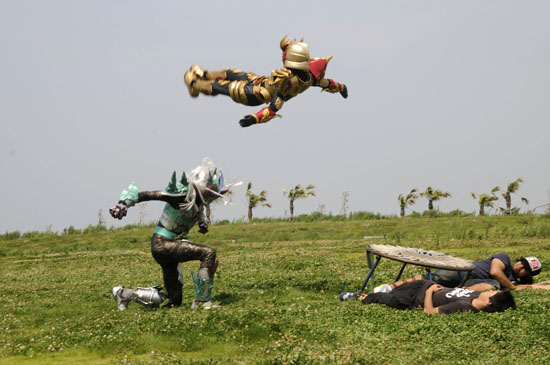
It’s already past lunch-time. The crew has finished the majority of an initial fight full of trampolines and some dynamic suit action. Mitsumizo is suited up, and now it’s Fangark and Yatsurugi (fully-suited and portrayed by a stuntman) needing to team up because it turns out the King Ogre we have seen is actually a fake! Mitsumizo quietly takes to himself to do some acting exercises and suddenly the volume has been turned up. The mild-mannered, deep-voiced gentleman is a little looser, more in feeling. He looks up to the imposter – “You aren’t my beloved King Ogre!” he snarls, waggling his sword in a rage.
With a slim crew and presumably accustomed town residents paying little heed to the proceedings, a vicious battle is going to rage in some sleepy sea port in Chiba. “At least, when we told people that we’re making this TV show called Yatsurugi, they saying ‘What’s that? ‘I’ve never seen it…’ and took more of a ‘Well do it yourself!’ kind of attitude. More recently, it’s become more like ‘Oh yeah, that show, let’s see how I can help you out’ and [the locals] have been pretty cooperative. That’s the kind of atmosphere it’s become.”
Houjin Yatsurugi is currently airing Saturdays on Chiba TV. The complete first season can be found on Yatsurugi‘s YouTube or website at www.yatsurugi.net.


